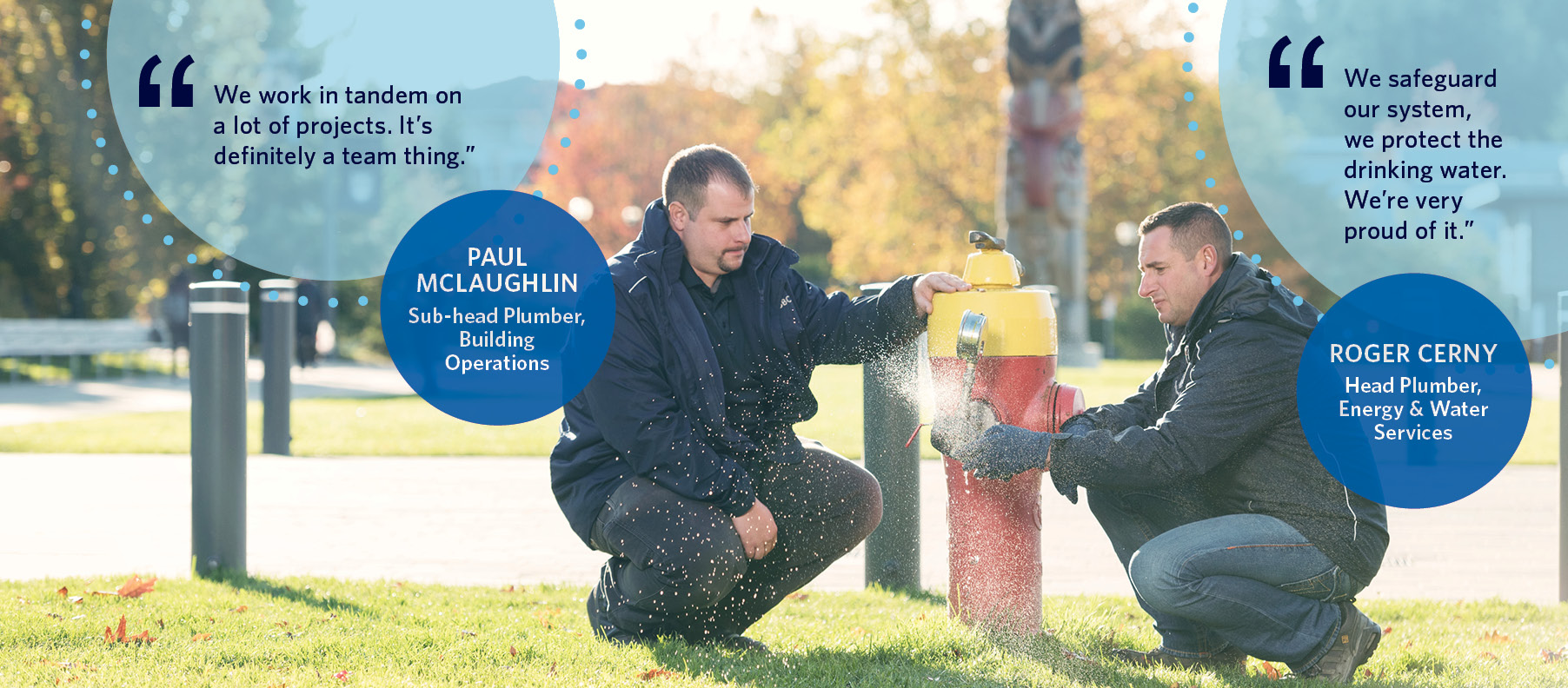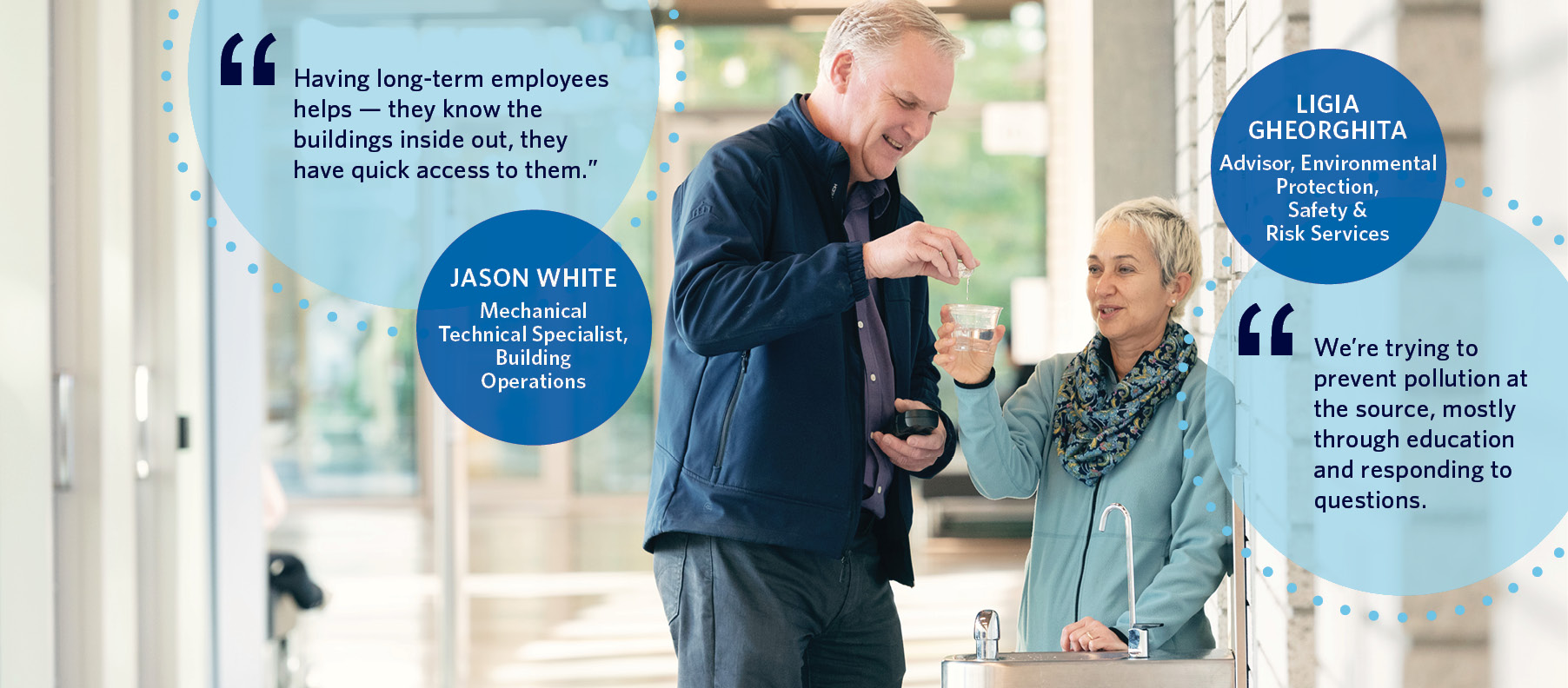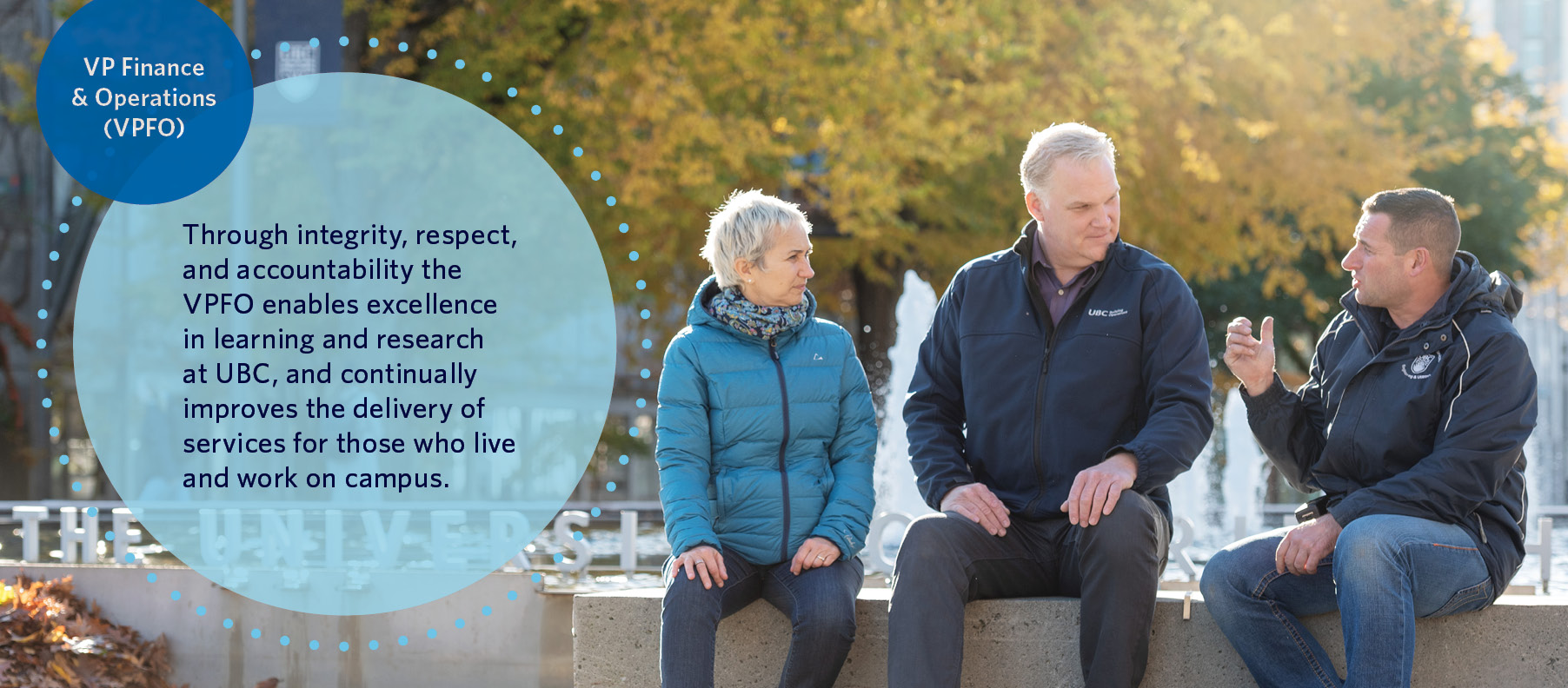The Flow of Water
Water is a crucial resource at UBC, for basic human needs and to support research and operations. The simple act of turning on a tap to access a safe and reliable water supply is something students, faculty, and staff depend on each and every day. But the story of how water gets to UBC’s Vancouver campus — and what happens when it gets here — is much more complex than most of us understand.
Although UBC isn’t technically a municipality, in many ways it operates like one — maintaining a vast infrastructure and supplying our own services, including waste management, energy generation and distribution, and infrastructure development. Managing our water alone is an intricate process involving staff members from across UBC’s VP Finance & Operations portfolio (VPFO). These individuals work in concert every day to ensure the university has a clean, safe, and sustainable resource on tap — by procuring, securing, testing, delivering, financially managing, and safely disposing of the university’s water. Through this work the VPFO makes sure water is available to support world-class research, to heat and cool our buildings, to water our campus living lab, and to be ready to drink.

Steady Under Pressure: Keeping Campus Flowing
UBC’s water is purchased from Metro Vancouver, and sourced from rain and melted snow in the mountainous watersheds that surround the city. Metro Vancouver tests and treats the water, then it travels many kilometres through pipes to the Sasamat storage reservoir in Pacific Spirit Park, adjacent to UBC.
![]() Our water enters the Vancouver campus through two trunk water mains. A pipe 600 mm in diameter (about 2 feet) runs below University Boulevard, and a 300 mm pipe (roughly a foot) enters below West 16th Avenue. The 600 mm pipe heads straight for the UBC Water Pump Station, where booster pumps increase the water pressure for distribution to the student residences and academic buildings in the north part of campus. The taller buildings in this zone need their water under higher pressure to reach upper floors in the event of a fire. The 300 mm pipe mostly supplies residential buildings and student residences along Lower Mall. Water arrives through the 300 mm main at sufficient pressure to service the shorter buildings in this zone. From those two entry points, water is distributed across campus through over 80 km of pipes and service connections.
Our water enters the Vancouver campus through two trunk water mains. A pipe 600 mm in diameter (about 2 feet) runs below University Boulevard, and a 300 mm pipe (roughly a foot) enters below West 16th Avenue. The 600 mm pipe heads straight for the UBC Water Pump Station, where booster pumps increase the water pressure for distribution to the student residences and academic buildings in the north part of campus. The taller buildings in this zone need their water under higher pressure to reach upper floors in the event of a fire. The 300 mm pipe mostly supplies residential buildings and student residences along Lower Mall. Water arrives through the 300 mm main at sufficient pressure to service the shorter buildings in this zone. From those two entry points, water is distributed across campus through over 80 km of pipes and service connections.
One of the many people involved in maintaining that maze of pipes is Roger Cerny, head plumber for UBC’s Energy & Water Services department. Roger, who has more than 15 years of experience on campus, oversees a dedicated crew to ensure the system stays in good working order and UBC’s spaces can fulfill their mission and purpose. “I have lots of senior people on my crew, and I’m very, very fortunate to have them,” Roger says. “We safeguard our system, we protect the drinking water. We’re very proud of it.”
In addition to the many kilometres of pipes Roger and his team maintain, the distribution system has 2,100 shutoff valves and 440 fire hydrants, each of which needs to be tested annually. The campus also has seven pressure-reducing valve stations and two check valves that ensure water is at the right pressure where it needs to be. And this is all before water even enters our buildings.
To make maintenance of all these components manageable, their locations and status are stored in a database. When Roger and his team test a valve, they use an iPad to scan a QR code on the item and register the inspection. The system continues to be expanded to include the thousands of assets managed by Energy & Water Services, making it easy to find and repair components across campus. “Anybody who finds a problem with any of our assets, like a fire hydrant leaking, can scan it and we would get that information and be able to do the repairs necessary,” Roger says. “It’s like we have extra eyes in the field — that really helps us out.”
Another vital part of Roger’s and his team’s work is to maintain the pipes themselves. He estimates that in 2018 alone they removed 2,200 metres of old cast iron water main, which are typically replaced with ductile iron pipes, which is more flexible and less susceptible to corrosion. The cost of this vital maintenance is built into the VPFO’s annual budget, which is managed by a team of financial experts within the portfolio.
![]() Once water enters a building, it becomes the responsibility of UBC Building Operations — another department of the UBC Facilities group in the VPFO. Sub-head plumber Paul McLaughlin, who has been with UBC for 13 years, notes the importance of having an experienced in-house team of plumbers, engineers and technicians on the VPFO team. “We know how everything works,” Paul says. “Everybody knows the buildings, and we know the people within buildings — that’s huge.”
Once water enters a building, it becomes the responsibility of UBC Building Operations — another department of the UBC Facilities group in the VPFO. Sub-head plumber Paul McLaughlin, who has been with UBC for 13 years, notes the importance of having an experienced in-house team of plumbers, engineers and technicians on the VPFO team. “We know how everything works,” Paul says. “Everybody knows the buildings, and we know the people within buildings — that’s huge.”
A vital aspect of the job is maintaining what’s known as the cross-connection control program, which ensures that water diverted to non-domestic uses like irrigation, boilers, fire prevention, and cooling towers, does not re-enter the drinking water system. In the event of a drop in water pressure, scores of backflow preventing devices across campus ensure that doesn’t happen. Maintaining and testing this complex system is essential for avoiding contamination of UBC’s water supply.
Underscoring the importance of having deep institutional knowledge to safeguard the system is Jason White, P.Eng, a UBC graduate and mechanical technical specialist for Building Operations. “The campus is a very complex place, and it’s hard to find things even if you work here,” Jason says. “In the beginning I couldn’t even find the water entry room where the backflow preventers are located. Having long-term employees helps — they know the buildings inside out, they have quick access to them.”
Paul notes the importance of his Building Operations team working closely with Roger and his crew at Energy & Water Services. “We collaborate on a lot of different things,” Paul says. “They sometimes need our team to help them and, in turn, we need their team to help us. We work in tandem on a lot of projects. It’s definitely a team thing.”

Testing at the Tap: Collaborating on Domestic Water Safety
Ensuring water flows without disruption isn’t Roger Cerny’s only responsibility. As a certified Level III water operator, Roger is also involved in testing the water to make sure it has maintained its quality after traversing several kilometres of pipes to reach the campus. It’s a vital part of the job, and supports the VPFO’s efforts to lead operational excellence at UBC. Every Tuesday, water is collected by Energy & Water Services staff from 16 sampling stations strategically placed throughout the water distribution system, then analyzed by a third-party lab for pH level, conductivity, turbidity, and many more parameters, to make sure it conforms to Health Canada standards.
Water quality is also a primary concern for Ligia Gheorghita, an environmental protection advisor with the VPFO’s Safety & Risk Services department. While Roger and his team sample the water in the main distribution system, Ligia oversees the testing of water inside campus buildings — at taps and drinking fountains.
![]() Twice per year, the water in several buildings across campus is sampled and analyzed. The buildings are typically tested twice in a row, to look for any changes in quality, and rotated, to make sure many buildings get tested. The results are reviewed and compared with Health Canada’s current guidelines for drinking water quality, and published on the Safety & Risk Services website.
Twice per year, the water in several buildings across campus is sampled and analyzed. The buildings are typically tested twice in a row, to look for any changes in quality, and rotated, to make sure many buildings get tested. The results are reviewed and compared with Health Canada’s current guidelines for drinking water quality, and published on the Safety & Risk Services website.
Ligia, who obtained her PhD from UBC in chemistry, has worked at the university for 18 years. She often fields queries about the quality of water in specific buildings and works with the VPFO’s Building Operations zone facilities managers to conduct ad hoc testing. Sometimes the results necessitate having fresh water flushed through the pipes, which may be done by Paul and his Building Operations team. “It’s sometimes a matter of flushing the system, because the building hasn’t been used in some time — if it’s not used in summer or if some construction went on,” Ligia says.
Ligia is also involved in the safety of another key aspect of water at UBC: its disposal.
UBC’s Vancouver campus has what’s known as a split system. Rainwater and melted snow drain into a stormwater system and are diverted back into the natural environment via storm outfalls, while domestic water — roughly 10 million litres per day — ends up in a separated sanitary sewer system when it goes down our drains and toilets. In the south part of campus, the sanitary sewage pipe travels straight south, while from the north, a sanitary sewer pipe veers north and east along the cliffs above Spanish Banks where it links up with the Metro Vancouver sewage network. Both ultimately arrive near the airport, to be treated at Metro Vancouver’s Iona Island Wastewater Treatment Plant.
The Iona plant is a primary treatment facility, meaning it removes large materials from the water but is not equipped for more advanced purification. Because the discharge from Iona ends up in the ocean, it’s vital that UBC prevents harmful materials, such as those that may be generated in labs or from research projects, from entering the sanitary sewer.
“We’re trying to prevent pollution at the source, mostly through education and responding to questions,” she says. Researchers on campus who suspect they might have harmful liquids are required to fill out an Aqueous Waste Profile form, which is reviewed by Ligia to determine how to properly dispose of the liquid. She and the team at Environmental Protection are essentially acting as an important filter to prevent harmful substances from ending up in the marine ecosystem.
How the Money Flows: Delivering on Systems Renewal
One of the VPFO’s strategic priorities is delivering on systems renewal — ensuring we have the right resources in place to succeed, and plans for maintaining and enhancing the resources to ensure they provide value into the future. Fortunately, a talented team of financial experts and accountants within the VPFO work together with the plumbers, engineers, and technicians to ensure a seamless, well-managed system that continues to improve.
Interestingly, UBC’s water is actually purchased from Metro Vancouver by the University Endowment Lands (UEL), which in turn sells it to the university. About 45 per cent of the water that arrives on campus is used by UBC itself, for academic and administrative campus services. Another 20 per cent is sold at market rates to ancillary services such as Student Housing and Hospitality Services, UBC Food Services, and the UBC Bookstore. The remaining 35 per cent is sold at market rates to external customers on campus, like homeowners, strata corporations, companies, and TRIUMF — UBC’s friendly neighbourhood particle accelerator.
![]() The finance team in Energy & Water Services bills these entities for other utilities too — electricity, natural gas, thermal energy, and use of the sanitary sewer system. Providing these services to the academic campus at well below market rates enables the savings to be reinvested in teaching, research and infrastructure, to support innovative new methods of learning and avenues of discovery.
The finance team in Energy & Water Services bills these entities for other utilities too — electricity, natural gas, thermal energy, and use of the sanitary sewer system. Providing these services to the academic campus at well below market rates enables the savings to be reinvested in teaching, research and infrastructure, to support innovative new methods of learning and avenues of discovery.
But billing for water use is just the beginning of the important work done by UBC’s financial team.
Sustainability is integrated into every aspect of life and work at UBC, and it’s top-of-mind for the finance and strategic planning teams too. That means that when the finance teams create their five-year financial plans, water-use trends and conservation targets are key considerations to reduce water and energy consumption.
“We have to build in those factors because things like reduction of water consumption are already part of our budget,” notes Dee Kaila, a Certified General Accountant by training who has worked at UBC for 27 years and currently serves as the associate director of finance for Energy & Water Services.
Dee was involved in the recent conversion of the university’s aging gas-fired steam heating system to a much more efficient hot water system, an epic project that began in 2011 and was completed in 2017. The collaboration between virtually every unit within VPFO, and many more, involved replacing 14 kilometres of 90-year-old steam piping and connecting 160 buildings to the far more efficient system. The transition was a key factor in reducing UBC’s absolute water use by a staggering 50 per cent since 2000, despite the campus expanding by leaps and bounds. Much more than a drop in the bucket.
Dee notes that business cases for capital projects use a 30-year time horizon, an approach that helps the university invest in ways that will enhance the campus well into the future. “We also recognize that as systems get older, we have to plan for upgrades and replacement. That’s built into the model.” She adds that capital projects are monitored closely over time to understand how actual conservation levels compare to the targets they set. “If the business case said it was supposed to do X per cent in savings, we want to know — did it actually do it?”
Dee adds that collaboration with other units, within VPFO and beyond, is the key to success. “When you look at accountants working with engineers, sometimes it’s not exactly the greatest fit,” she adds. “But you know, they’re a great team to work with.”

Going with the Flow: The Big Picture
On campus, countless times a day, tens of thousands of people turn on taps and expect to see water come out — whether it’s from a drinking fountain in the Museum of Anthropology, in a lab in the Chemistry Building, a patient room at Djavad Mowafaghian Centre for Brain Health, or a shower at the UBC Recreation Centre. Behind the scenes, VPFO staff members with diverse areas of expertise work together to make sure the flow is steady, sustainable, and secure, in support of UBC’s academic mission and vision. Through integrity, respect, and accountability the VPFO enables excellence in learning and research at UBC, and continually improves the delivery of services for those who live and work on campus. Nowhere is that more evident than in how we safely manage and maintain our water infrastructure — after all, it’s vital to every aspect of life at UBC.
UBC’s VPFO: enabling excellence in learning and research
The VPFO is responsible for stewardship of UBC’s physical and financial assets, including all facilities as well as the university budget and endowment. The services provided by the 1200+ individuals who report to the portfolio enable UBC’s excellence in learning and research.
Read more about the VPFO and how we are focused on enabling excellence in learning research at UBC at vpfo.ubc.ca/strategy.